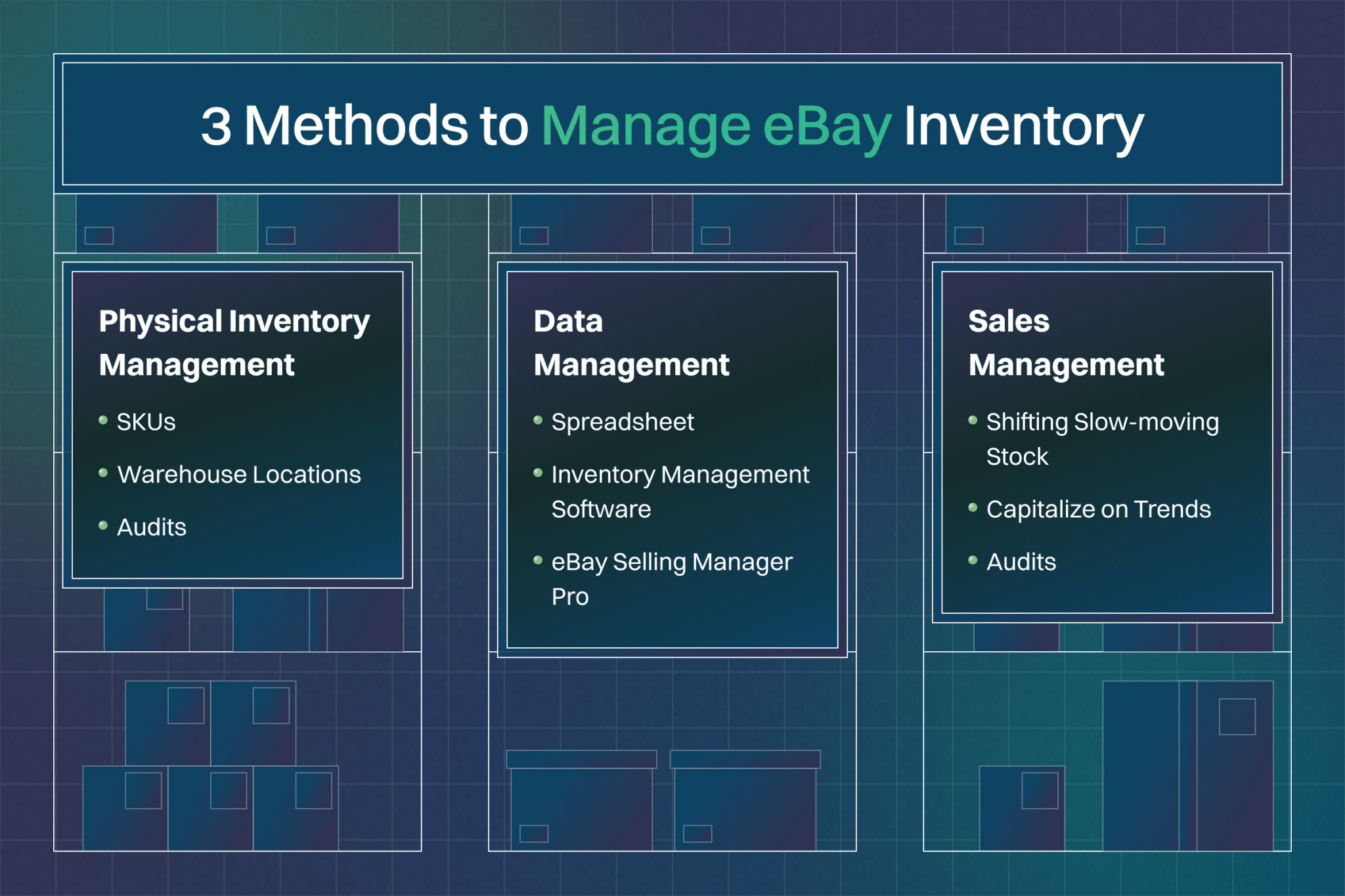
It seems hard to believe, but eBay has been around for a quarter of a century. The online auction site has changed the way we shop, helped people launch legitimate businesses, and generated untold billions of dollars during that span.
Perhaps the most impressive change is how eBay has allowed small businesses to reach a broader base of customers by creating a global marketplace where you can sell (almost) anything to anyone, anywhere, at any time.
Whether you run a small online business that supplements your day job income or your company generates major revenue selling through the site, one thing that can’t be understated is the importance of managing your eBay inventory.
The same challenges and headaches that brick-and-mortar online retailers deal with regularly apply to eBay as well. Today, we’ll tell you how to avoid those problems so you can continue to meet the demands of your customers.
How to Manage Your eBay Inventory
When it comes to how to keep track of your eBay inventory, you’ve got options.
That being said, any truly useful eBay inventory system is going to have three main components:
- Physical Inventory Management
- Data Management
- Sales Management
Each of these elements plays a vital role in ensuring you’re getting an accurate picture of how your business is performing and that your inventory management program is working effectively.
Let’s break down each of the three pillars in more detail.
-
Physical Inventory Management
The most obvious starting point when it comes to eBay inventory management is physical inventory.
Proper management of your physical inventory helps you sell more items (because the items are available when customers want to purchase them), will impact your warehouse and carrying costs, and even determines how quickly you can ship items (eBay offers fast shipping programs that sellers will want to qualify for).
There are three key areas to consider when thinking about your physical inventory management program
- SKUs
- Warehouse locations
- Audits
Understanding each of these areas will give you a much better handle on your physical inventory needs.
-
SKUs
SKUs are an alpha-numeric code for easily tracking your products in inventory. The acronym stands for “stock keeping unit.” SKUs will often look like random gibberish to the casual observer, but each letter and number in a SKU actually contains valuable information that will make tracking your products easier.
We’ve written an extensive post on how to create SKUs.
SKUs will help you manage your inventory in a variety of different ways. Here are three of the biggest: stock levels, efficiency, and replenishment.
Stock levels for eBay businesses work in the same way as they do for other storefronts. Understanding your stock levels can save you money by helping you avoid carrying excess stock you don’t need. It can also help you make more money by guaranteeing you don’t run out of items that customers want.
When it comes to efficiency, SKUs help your warehouse staff better fulfill orders. A smart warehouse layout with easy-to-find SKUs will not only increase the speed at which orders are filled and shipped, but can reduce the number of improperly filled orders that require returns.
And finally, SKUs can help you stay on top of your replenishment for key items. eBay business management software can track your stock levels by SKU and re-order when certain conditions are met. This helps prevent you from selling out of an in-demand item.
Subscribe and receive tips that build trust with and delight your buyer
-
Warehouse Locations
Far too often, companies fail to really consider how the physical locations of their warehouses might affect their business. This applies to eBay businesses as well as online and traditional retailers.
While real estate or rental prices are always a driving concern when it comes to acquiring warehouse space, the physical location matters as well. Placed strategically, your warehouses can increase the speed at which you ship items to customers.
Commonly, there’s a tendency for companies to want to have one huge warehouse near the corporate headquarters. On the surface, this makes sense. Having everything in one central location near your base of operations makes management easier.
However, in most instances, this means shipping to various parts of the country (or globe) will be more challenging because of simple geography.
Rather than opt for one giant warehouse, many businesses are better served by having multiple smaller warehouses spread out across the various regions where they do the bulk of their business.
That being said, some companies may not be big enough or have the financial resources to utilize multiple warehouses. In these instances, it’s often beneficial to split your inventory between your warehouse and eBay fulfillment partner.
-
Audits
Finally, we come to audits.
Physical audits of your inventory should be conducted on a regular basis. They allow you to check stock levels, spot potential problems and optimize your warehouse for maximum efficiency.

-
Data Management
Since an eBay store is largely an online endeavor, most owners tend to think of data management when the topic of inventory management comes up.
Data management in this space can cover a lot of diverse issues, but it all basically boils down to understanding information about your stock levels so you can make better decisions.
For example, understanding how long items sit in your warehouse on average can help you prioritize future replenishment rates. Inventory software for eBay can help you find and understand this information.
With that in mind, here are some of the key ways to track your eBay inventory data.
-
Spreadsheets
We begin with the tried and true low-tech solution: the spreadsheet.
If you’re a smaller eBay retailer, then this approach might be the best way to get started. Spreadsheet software is readily available, easy to use, and very affordable.
The potential downside here is that spreadsheets don’t offer the functionality or timeliness of inventory management software. This might not be a deal-breaker for a smaller seller who doesn’t move a lot of product, but if you’re running a high volume business then the spreadsheet is probably not the best option. It requires more labor as people must input data into the sheet, and that makes it more prone to error than the automated software options on the market.
-
Inventory Management Software
Inventory management software has been a game-changer for countless industries, and the benefits of this technology can be applied to your eBay business too.
Where the spreadsheet requires constant input from humans and is prone to errors, inventory management software automates many of the processes required to keep your inventory in order.
For example, inventory management software can alert you to low stock levels, order replenishment, and provide you with a huge range of analytical insight into how your business is performing.
There are a plethora of inventory management software options on the market, with solutions available for every budget. It’s simply a matter of researching your options, finding ones that fit your needs, and scheduling trials and demos.
-
eBay Selling Manager Pro
eBay already offers an inventory management solution in the form of its selling manager system, but for $15.99 a month, you can access a more advanced inventory management tool in the form of eBay Selling Manager Pro.
This upgraded option allows you to monitor inventory levels, schedule replenishment, and perform other duties.
The downside of eBay Selling Manager Pro is that it doesn’t work with third-party tools. Because of this, if you’re monitoring inventory through channels beyond eBay, this won’t actually make your life easier.
Sales Management
The last pillar of successful eBay inventory management involves your sales management.
Sales management can help you increase sales in a number of ways, including:
-
Shifting Slow-Moving Stock
By looking at your physical inventory audits and data analysis, you should be able to quickly spot items that aren’t selling.
Armed with this information, you can then figure out ways to remove this dead stock from your inventory. Perhaps you’ll place these items on sale, offer them in bundles, or market them as clearance items.
However you approach it, the goal here is to eliminate inventory that isn’t driving business.
-
Capitalize on Trends
Another huge benefit of understanding your inventory is that it allows you to better spot trends before they happen, allowing you to capitalize on the “next big thing.”
The data you collect on your inventory over time will allow you to better understand when certain products sell well, meaning you’re better positioned to make sure you have plenty of those items on hand before demand surges.
Conversely, you will also know when not to make major re-orders when items are about to go out of season.
Benefits of Using eBay Inventory Software
As we mentioned earlier, if you’re a smaller eBay seller or just getting started, the old spreadsheet method is probably a good starting point.
However, bigger sellers will benefit from eBay inventory software. These solutions will remove a lot of the busywork of recording data manually, eliminate potential human error, and automate many of your processes so you’re free to focus on actually running and growing your business.
If you haven’t considered eBay inventory software for your store, take some time and explore what’s out there. There truly is a solution for everyone.
Final Thoughts
The value of inventory management can’t be understated, whether you’re running a traditional store, selling online, or working exclusively through eBay.
Poor inventory management practices cost companies money in the form of lost sales and excess product loads. Fortunately, using inventory management best practices, coupled with inventory management software can turn your eBay business into a top performer in no time.
Ready for more ways to level up your online selling? Learn about the best eBay selling tools that can help you run a better eCommerce business.

